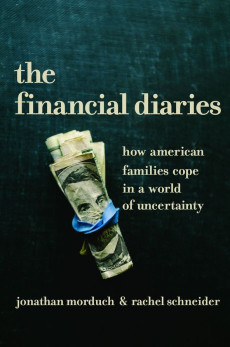
The Financial Diaries: How American Families Cope in a World of Uncertainty
Jonathan Morduch
223 pages, Princeton University Press, 2017
Back in 2008, Yale University’s Jacob Hacker dubbed major swings in annual income “the new insecurity” and attracted attention in both scholarly circles and the media to what people could immediately see was a big problem. People’s spending, especially on major goods and services such as housing, cars, and their children’s college education, requires stable income. But as impressive datasets such as the Panel Study of Income Dynamics (PSID) demonstrate, income is far from stable for many American households.
In tracking the same families over multiple years, the PSID yielded important information about annual income volatility. Jonathan Morduch and Rachel Schneider’s new book, The Financial Diaries: How American Families Cope in a World of Uncertainty, provides a more close-up view, looking at the financial transactions of households on a monthly and even weekly basis to reveal a new type of financial insecurity.
None of the existing big datasets offer this type of detailed household information. So how was it possible for Morduch and Schneider to obtain it? The answer is simple: They went out and collected it themselves. They selected four communities across the United States, in California, Mississippi, New York, and the Ohio-Kentucky border; identified low- to middle-income households through referrals from local organizations; and met new families using references from ones already participating in the study. The only requirement for a household to participate was that it include at least one worker. The researchers then asked each household to take notes on every financial transaction in which it was involved, including earnings transfers, purchases, bill payments, and borrowing. The 235 families that completed the yearlong study recorded an astounding average of about 1,275,000 transactions per household. Given the heavy burden of reporting this data, it’s little wonder that 165 households, or about 40 percent of the original 400, dropped out of the study before it ended.
The most important observation from this research is just how much the average household’s income varied over the year. The authors looked at the number of months (out of 12) when each family’s income came in at more than 25 percent above or below its monthly average. They found that over the year, households experienced an average of 2.2 months when income spiked above the 25 percent level and 2.4 months when it dipped below. That adds up to nearly five months per year when the average household’s income was very different from its monthly standard. Only about 2 percent of households didn’t see at least one month with this level of variance. Poorer households experienced more volatility, but it significantly affected even households with incomes of more than 200 percent of the poverty level.
Morduch and Schneider bring home the seriousness of these swings in income and the problems that result through detailed stories of the real families that participated in the study. Descriptions of the problems facing these people, which make up about half of the book, have a powerful effect on the reader. Financial planning is all but impossible when income isn’t reliable. Families find that borrowing, sometimes at high rates, is often necessary, making financial problems greater still. Even using safety net programs becomes difficult when family eligibility for benefits varies from month to month. And, not surprisingly, huge swings in income also increase worrying, which often leads to tension and conflict between members of the household.
Morduch and Schneider also give impressive examples of how families have tried to cope with the shortfalls in income they so frequently experience. Families may borrow money, often from friends and relatives; manage to build small pools of savings; work extra jobs or hours; and persuade their creditors to extend the due dates of bills. But the authors find that these solutions, creative though they may be, usually provide no more than temporary relief.
The most significant flaw in the study is that the sample, collected through local networks in specific communities, isn’t necessarily representative of the overall US population. Even so, the fact that the authors selected families from four different areas of the country and from a wide range of income levels provides at least some reassurance that the striking income volatility the authors document is reasonably widespread.
The authors conclude by providing a brief set of suggestions for policies that might help families cope. They favor laws that would limit employers’ ability to change employee work hours frequently and at the last minute, and regulations on marketing practices of financial products such as high-interest payday loans that can lead families into ever-increasing cycles of debt. But the evidence that these policy suggestions would be effective is lacking. Although short-term income volatility afflicts many families, it’s not yet clear which policies would do most to address the problem. At this point, further studies that test such policy proposals may be the best hope for helping struggling families like the ones profiled in this book.

